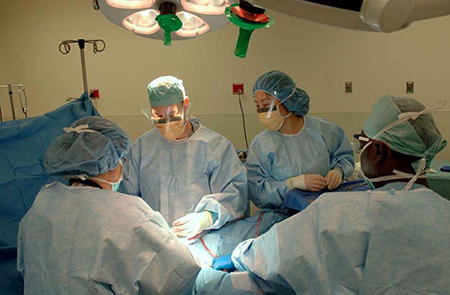You are here: Home > Unit on Reproductive Endocrinology and Infertility
Reproductive Endocrinology and Infertility

- James Segars, MD, Head, Unit on Reproductive Endocrinology and Infertility
- Alicia Armstrong, MD, Associate Fellowship Program Director, Reproductive Endocrinology and Infertility
- William H. Catherino, MD, PhD, Special Volunteer
- Hisashi Koide, MD, PhD, Visiting Fellow
- Xiu-Ye Xing, MD, Visiting Postdoctoral Fellow
- Kimberly M. Baig, BS, MD/PhD Student
- Tiffany Chu, BS, Postbaccalaureate Intramural Research Training Award Fellow
The Unit on Reproductive Endocrinology and Infertility supports basic, translational, and clinical studies on reproductive disorders. Current research focuses on uterine leiomyomas (fibroids), endometriosis, health disparities, and reproductive disorders leading to infertility in women. We also support the accredited NICHD-USUHS Clinical Fellowship Program in Reproductive Endocrinology and Infertility.
Uterine leiomyomas

Click image to enlarge.
Figure 1. Surgeons in the Unit remove a symptomatic uterine leiomyoma.
The Unit on Reproductive Endocrinology conducts clinical, translational, and basic science studies of uterine leiomyoma.
Fifty percent of women in the United States develop uterine fibroids during their reproductive years, making the condition the most prevalent reproductive disorder of women. Despite its prevalence, the condition remains poorly understood. In the past year, we completed a cost estimate of the effect of uterine fibroids on the US health care system. We estimated that fibroids may represent a burden of up to $34 billion dollars annually, if adverse effects on reproduction are considered (1). One prominent feature of uterine fibroids is that the cells within the tumors produce a disordered and excessive extracellular matrix (ECM). In earlier work, we examined the characteristics of the cells that might lead to production of this excessive and fibrotic ECM and obtained evidence that mechanical signaling—a method of cell communication and activation—was attenuated in cells within a fibroid. Recently, we examined surgical specimens and immortalized leiomyoma and myometrial cells and indeed found that mechanical signaling was lower in leiomyoma cells than in myometrial cells. Furthermore, given that anti-progestins cause reduction in fibroid size, we analyzed surgical specimens from patients treated with anti-progestins. Anti-progesterone–treated fibroids revealed altered phosphorylation of proteins involved in mechanical signaling. Collectively, the findings suggest that altered mechanical signaling may contribute to leiomyoma growth (2).
Role of BRX (also known as AKAP13) in osmotic stress, inflammation, and development
Our previous studies of the gene BRX (now known as AKAP13), which we cloned, indicated that the gene encoded a large Rho-GEF proto-oncoprotein that is involved in estrogen and glucocorticoid receptor activation. In a recent collaborative study with Tomoshige Kino, using mice haploinsufficient for BRX, we found that BRX was critical to the response of lymphocytes to osmotic stress through a pathway involving the nuclear factor of activated T cells 5 (NFAT5) and JIP4. In the past year, we examined the consequence(s) of haploinsufficiency for AKAP13 and began analysis of the Cre-Lox AKAP13 tissue–specific deletion in the heart of adult mice. The studies support a role for AKAP13 in cardiac function and deepen our understanding of the in vivo function of the gene.
Infertility and reproductive health disparities
We continued to conduct studies on infertility and reproductive health disparities. Previously, we examined health disparities in reproductive outcome in women undergoing assisted reproduction treatments. The clinical study indirectly examined the hypothesis that poorer pregnancy outcomes observed in African-American women than in Caucasian women are a result of altered endometrial responses possibly owing to higher levels of estrogen during the ovarian stimulation. Consistent with that hypothesis, when the endometrium was prepared similarly for embryo transfer, no ethnic differences in pregnancy rates were observed. In the past year, we examined factors such as cost in utilization of reproductive technologies by minority women. We found that economics and access to care influences use by African-American women but not by Hispanic women. Furthermore, despite increased use of assisted reproductive technologies by African American women, outcomes were worse than for Caucasian women. The results suggest that improved access to care may not translate into improved outcomes in some ethnic groups. In the past year, we examined the role that in utero events and trans-generational epigenetic marks may play in reproductive health disparities.
Publications
- Cardozo ER, Clark AD, Banks NK, Henne MB, Stegmann BJ, Segars JH. The estimated annual cost of uterine leiomyomata in the United States. Am J Obstet Gynecol 2012;206:211.e1-9.
- Norian JM, Owen CM, Taboas J, Korecki C, Tuan R, Malik M, Catherino WH, Segars JH. Characterization of tissue biomechanics and mechanical signaling in uterine leiomyoma. Matrix Biol 2012;31:57-65.
- Malik M, Segars J, Catherino WH. Integrin beta 1 regulates leiomyoma cytoskeletal integrity and growth. Matrix Biol 2012;31:389-97.
- Owen CM, Goldstein EH, Clayton JA, Segars JH. Racial and ethnic health disparities in reproductive medicine: an evidence-based overview. Semin Reprod Med. 2013;31(5):317-24.
- Tal R, Segars JH. The role of angiogenic factors in fibroid pathogenesis: potential implications for future therapy. Hum Reprod Update 2013;Epub ahead of print.
Collaborators
- Paul Driggers, PhD, Uterine Fibroid Tissue Bank, USUHS-NICHD, Bethesda, MD
- Tomoshige Kino, PhD, Program in Reproductive and Adult Endocrinology, NICHD, Bethesda, MD
- Phyllis Leppert, MD, PhD, Duke University, Durham, NC
- Lynnette Nieman, MD, Program in Reproductive and Adult Endocrinology, NICHD, Bethesda, MD
- Pamela G. Robey, PhD, Craniofacial and Skeletal Diseases Branch, NIDCR, Bethesda, MD
- Heiner Westphal, MD, Program in Genomics of Differentiation, NICHD, Bethesda, MD
- Bradford J. Wood, MD, Center for Interventional Oncology, NIH Clinical Center, Bethesda, MD
Contact
For more information, email segarsj@mail.nih.gov.

